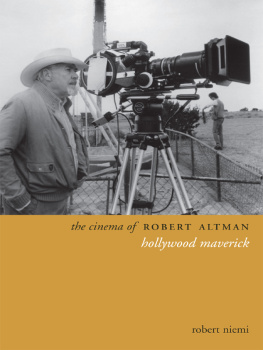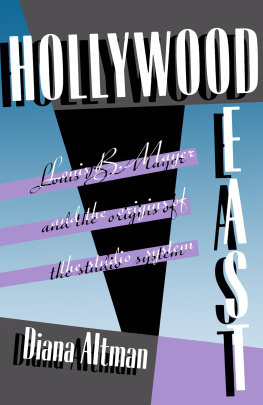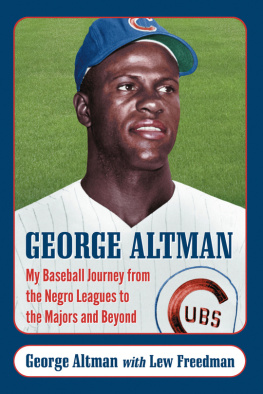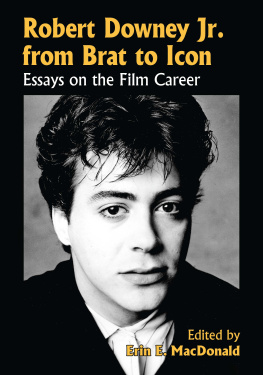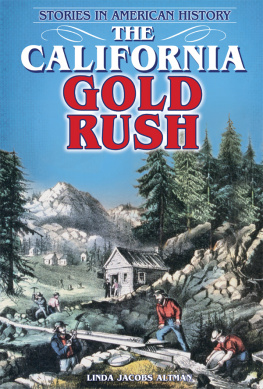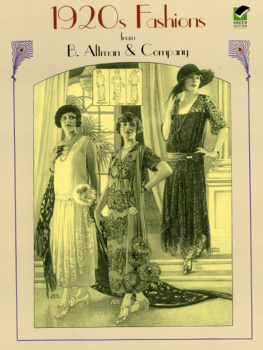Table of Contents
the cinema of ROBERT ALTMAN
DIRECTORS CUTS
Other selected titles in the Directors Cuts series:
the cinema of SEAN PENN:in and out of place
DEANE WILLIAMS
the cinema of CHRISTOPHER NOLAN:imagining the impossible
JACQUELINE FURBY & STUART JOY (eds)
the cinema of THE COEN BROTHERS:hardboiled entertainments
JEFFREY ADAMS
the cinema of CLINT EASTWOOD:chronicles of america
DAVID STERRITT
the cinema of ISTVN SZAB:visions of europe
JOHN CUNNINGHAM
the cinema of AGNS VARDA:resistance and eclecticism
DELPHINE BNZET
the cinema of ALEXANDER SOKUROV:figures of paradox
JEREMI SZANIAWSKI
the cinema of MICHAEL WINTERBOTTOM:borders, intimacy, terror
BRUCE BENNETT
the cinema of RAL RUIZ:impossible cartographies
MICHAEL GODDARD
the cinema of MICHAEL MANN:vice and vindication
JONATHAN RAYNER
the cinema of AKI KAURISMKI:authorship, bohemia, nostalgia, nation
ANDREW NESTINGEN
the cinema of RICHARD LINKLATER:walk, dont run
ROB STONE
the cinema of BLA TARR:the circle closes
ANDRS BLINT KOVCS
the cinema of STEVEN SODERBERGH:indie sex, corporate lies, and digital videotape
ANDREW DE WAARD & R. COLIN TATE
the cinema of TERRY GILLIAM:its a mad world
JEFF BIRKENSTEIN, ANNA FROULA & KAREN RANDELL (eds)
the cinema of TAKESHI KITANO:flowering blood
SEAN REDMOND
the cinema of THE DARDENNE BROTHERS:responsible realism
PHILIP MOSLEY
the cinema of MICHAEL HANEKE:europe utopia
BEN McCANN & DAVID SORFA (eds)
the cinema of SALLY POTTER:a politics of love
SOPHIE MAYER
the cinema of DAVID CRONENBERG:from baron of blood to cultural hero
ERNEST MATHIJS
the cinema of JAN SVANKMAJER:dark alchemy
PETER HAMES (ed.)
the cinema of LARS VON TRIER:authenticity and artifice
CAROLINE BAINBRIDGE
the cinema of WERNER HERZOG:aesthetic ecstasy and truth
BRAD PRAGER
the cinema of TERRENCE MALICK:poetic visions of america (second edition)
HANNAH PATTERSON (ed.)
the cinema of ANG LEE:the other side of the screen (second edition)
WHITNEY CROTHERS DILLEY
the cinema of STEVEN SPIELBERG:empire of light
NIGEL MORRIS
the cinema of TODD HAYNES:all that heaven allows
JAMES MORRISON (ed.)
the cinema of DAVID LYNCH:american dreams, nightmare visions
ERICA SHEEN & ANNETTE DAVISON (eds)
the cinema of KRZYSZTOF KIESLOWSKI:variations on destiny and chance
MAREK HALTOF
the cinema of GEORGE A. ROMERO:knight of the living dead (second edition)
TONY WILLIAMS
the cinema of KATHRYN BIGELOW:hollywood transgressor
DEBORAH JERMYN & SEAN REDMOND (eds)
the cinema of
ROBERT ALTMAN
hollywood maverick
Robert Niemi
A Wallflower Press Book
Published by
Columbia University Press
Publishers Since 1893
New York Chichester, West Sussex
cup.columbia.edu
Copyright 2016 Robert Niemi
All rights reserved
E-ISBN 978-0-231-85086-5
Wallflower Press is a registered trademark of Columbia University Press
A complete CIP record is available from the Library of Congress
ISBN 978-0-231-17626-2 (cloth : alk. paper)
ISBN 978-0-231-17627-9 (pbk. : alk. paper)
ISBN 978-0-231-85086-5 (e-book)
Series design by Rob Bowden Design
Cover image of Robert Altman courtesy of Kobal Collection
A Columbia University Press E-book.
CUP would be pleased to hear about your reading experience with this e-book at .
CONTENTS
For Keechie (Connie), she of infinite patience and good cheer
I offer thanks to Kate Hutchins and Peggy Daub of the Special Collections Library, University of Michigan at Ann Arbor, where the Robert Altman Archive is housed. They and other archivists were most helpful in accommodating my research visit to the Altman Archive in the summer of 2013. A hearty thanks to St. Michaels College, for generously subsidizing that important and inspiring trip through a faculty development grant and for faithfully supporting my research and writing endeavours over the last twenty-five years through numerous other grants and three sabbaticals. I am blessed to work at such a place. Thanks also to the folks at St. Michaels Durick Library, who were quick and efficient in fulfilling inter-library loan requests and purchasing Altman DVDs. I also want to acknowledge Ron Jacobs for being a friend, colleague, stimulating conversationalist and kindred spirit. His passionate, encyclopedic knowledge of counterculture history and radical politics far exceeds my own. Special thanks to Lorrie Smith, who has been a supportive and emotionally generous SMC colleague and the kindest of friends. Thanks, also, to Bill Grover, Jeff Ayres, Richard Kujawa, Joan Wry, Toni Messuri, Bill Ellis, Herb Kessel, George Dameron, Katie Kirby, Phil Yates and Joel Dando for sharing stories about life in the (teaching) trenches and reflections on film, music, pop culture and politics. Their friendly collegiality is much appreciated. On the editorial front I owe a huge debt of gratitude to Yoram Allon, Commissioning Editor at Wallflower Press. This book would never have come to fruition if it were not for his patient commitment, a commitment which never wavered even when mine did. Thanks, Yoram, for believing in me. You are a scholar and a gentleman. Finally, my warmest thanks go to my wife, Connie Dufour, who put up with this long ordeal, watched a lot of Altman movies with me, listen to me drone on, and came to share my passion for his work. Youre simply the best.
Writing a book on Robert Altman can be a daunting, even scary undertaking. Ever since he started attracting notice in the late 1960s, up until his death in 2006 and beyond, some twenty books and hundreds of articles and reviews have been published on Altman and his uneven but magnificent body of work. What would justify another book on Altman? What can one say about this legendary American film director that has not already been said, and said well, by so many others? That question dogged me during the early, tentative stages of this project. Gradually, after a lot of thought and research and a number of false starts and conceptual dead-ends, a realisation began to take shape. It occurred to me that there has been altogether too much emphasis placed on the two most obvious aspects of Altmans career: as an innovative cinematic artist and as Hollywoods enfant terrible, an untamed and unrepentant rebel against film industry business practices and aesthetic conventions. Both these perspectives have great merit, of course, but it seems to me neither is sufficiently

